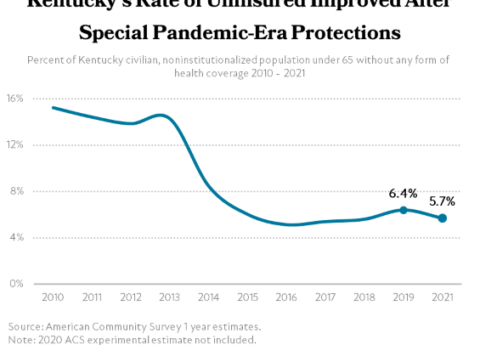One of the most powerful investments we can make in a child’s life is high-quality early childhood care and education, which research shows results in improved outcomes later in life, including higher educational achievement, more stable employment and higher incomes, and improved mental and physical health. Yet currently, half of all Kentuckians live in a child care desert, meaning there are far too few licensed child care spots for all the children who need them, and even fewer high-quality spots. A new report from the Kentucky Center for Economic Policy explains why investment in child care through the Build Back Better Act now in front of Congress is imperative.
“As a parent myself, I know how important, yet how difficult it is for Kentucky families to find high-quality child care. We need to know that our kids are being consistently cared for and taught well, especially at such a critical stage of their lives, so that we as parents and guardians can go to work without having to worry about their wellbeing,” said Dustin Pugel, Senior Policy Analyst and author of the report.
The report describes how inadequate public investment in child care results in unaffordable care, too few providers and high rates of turnover among underpaid teachers. Public revenue, which largely flows through the Child Care Assistance Program (CCAP), comprises just 34.7% of child care provider revenue in Kentucky. And while CCAP does help low-income families pay for child care, CCAP participation has been on the decline for nearly a decade following a 2013 moratorium due to a state budget shortfall. In 2019, while 126,900 Kentucky kids were in income-eligible families, just over 25,000 participated in CCAP.
As a result, the bulk of the cost burden falls on families for this critical public good. At current market rates — which are far below what is needed for a high-quality standard of care — the average cost for center-based, full-time child care for toddlers, for example, is a prohibitive $35.55 per day. That’s equivalent to 17% of the state median income in Kentucky.
When families can’t pay and public investment is inadequate, reduced job quality for teachers is one of the consequences. In 2020, average annual pay for child care workers in Kentucky was $20,423 — under the poverty line for a family of 3, and low enough to make the average child care worker eligible for CCAP. Women comprise 9 in 10 child care workers, and Black women are disproportionately likely to work in child care. These low-quality jobs have high rates of turnover, and Kentucky’s child care workforce, already small before the pandemic, shrank 22.5% in the last year during the pandemic.
“We have long treated child care like a market, but that model that has failed Kentucky’s kids. Families can’t afford care, providers can’t keep their doors open, and low-quality jobs fail to attract and keep the best workers for these important jobs,” said Pugel. “But the story is not all bad. Recent federal pandemic relief packages have improved CCAP and provided direct support to providers. It’s a proof-of-concept for what a permanent, widely-available, publicly supported child care system could look like in Kentucky.”
Worker bonuses, sustainment stipends for providers (which are used for things like payroll, bonuses and fixed costs like rent), training for workers, stabilization grants for centers meeting certain standards including a base pay rate for teachers, and increased CCAP eligibility and reimbursement rates are among the pandemic provisions that have lessened COVID’s toll on the industry.
The Build Back Better plan now in front of Congress would go beyond stabilization, funding a child care entitlement that would effectively eliminate child care costs for families earning up to 75% of state median income. The plan would also cap child care costs at no more than 7% of income for families with incomes above that threshold up to 2.5 times the state median income. It would also create universal preschool for children 3 and 4 years old. Combined, these investments would expand child care capacity, upgrade quality and improve affordability across the state.
“We desperately need Congress to provide this transformative, permanent increase in federal funding for child care; if and when that happens the Kentucky General Assembly will need to partner in implementing that expansion,” said Pugel. “Hanging in the balance are the wellbeing of Kentucky’s kids, the quality of life among child care instructors, and the long-term viability of an industry that is essential to the rest of the economy.”
Read the full report by clicking this link.


